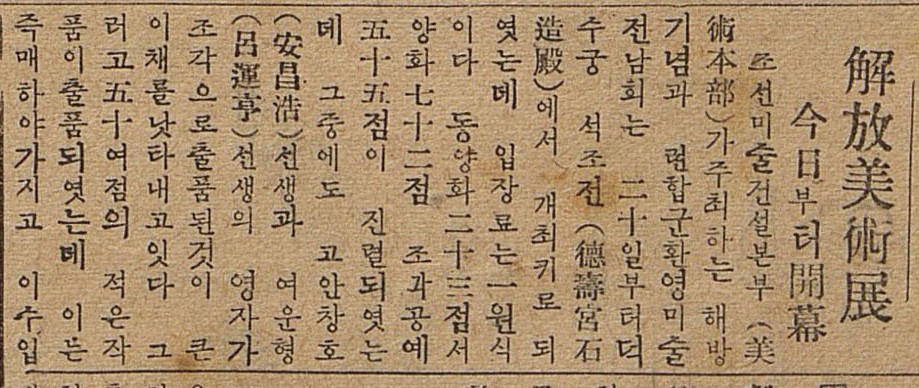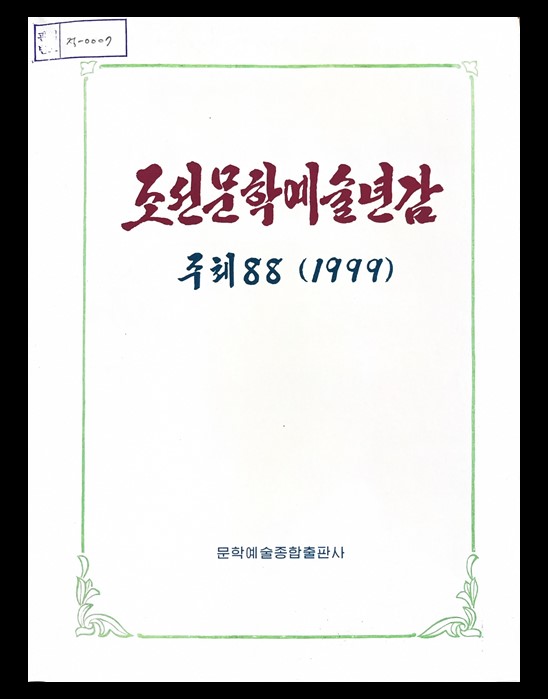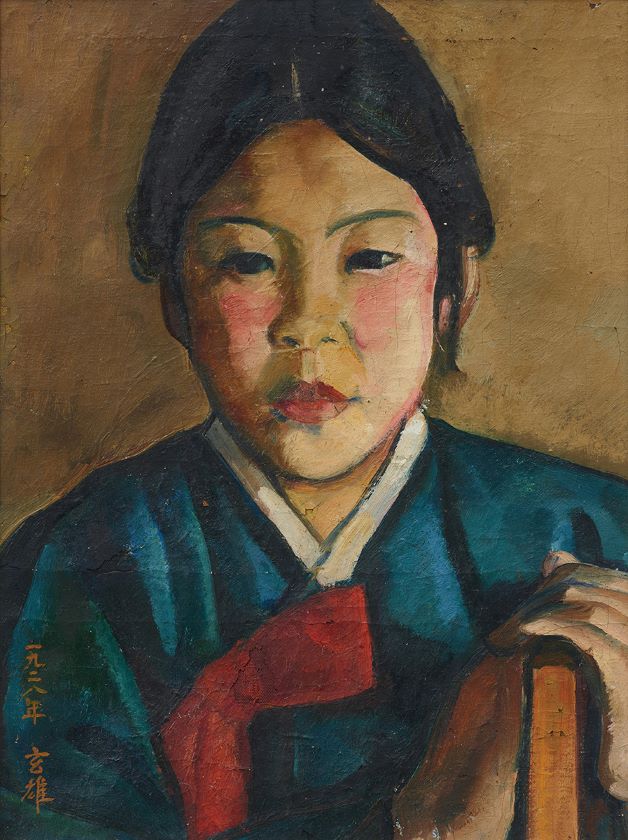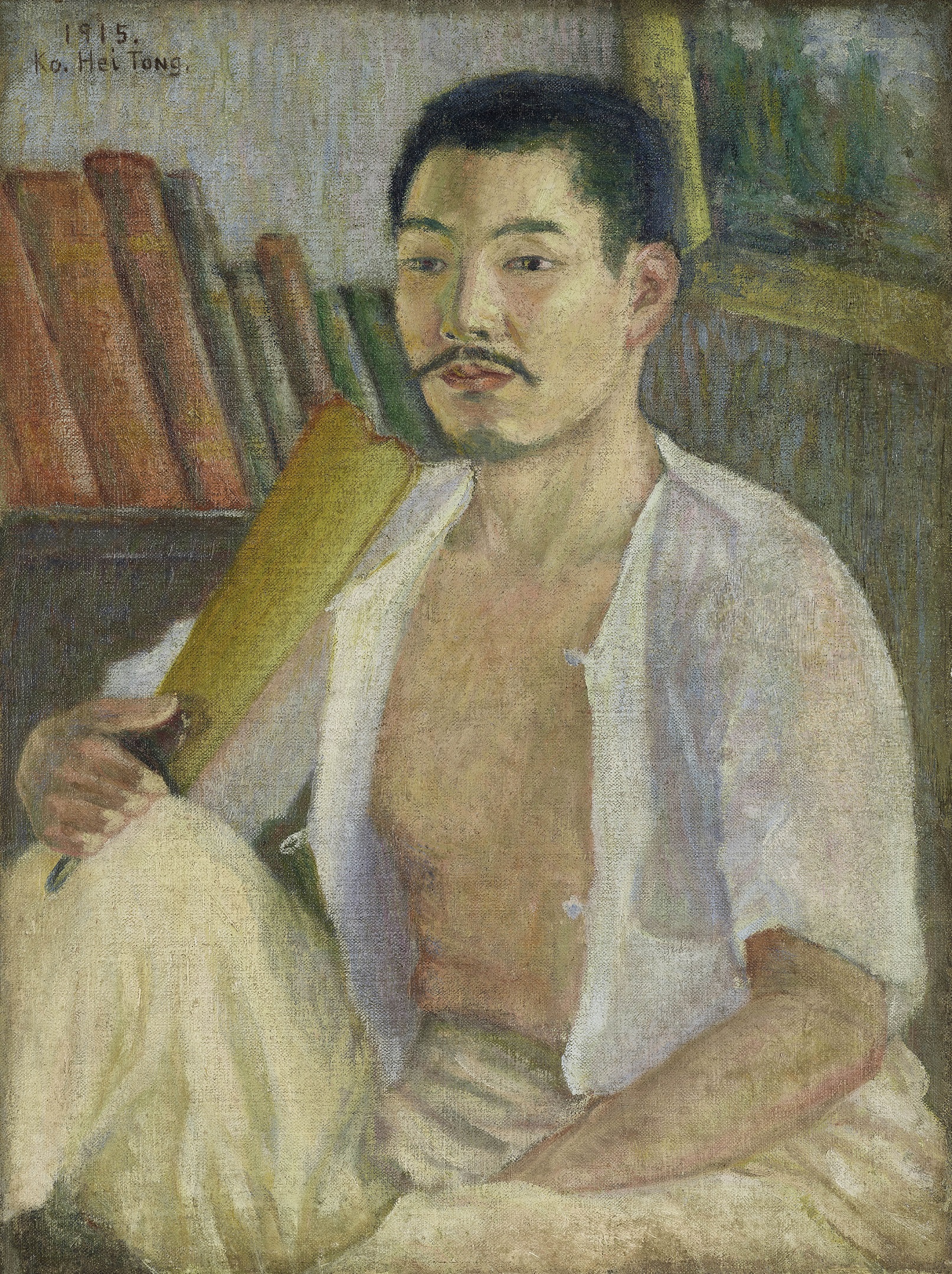
“Inheritance of Cultural Heritage and the Advance of Construction of a New Culture—Activities of the Central Committee for the Construction of Korean Culture,” Sinjoseonbo, October 7, 1945, 2, column 2
Central Committee for the Construction of Korean Culture
* Source: Multilingual Glossary of Korean Art. Korea Arts Management Service
Related
-

Korean Art Construction Headquarters
An artist organization established in August 18, 1945 and dissolved November 20, 1945. The founding of the organization was led by Kim Jukyung, Jeong Hyeonung, Gil Jinseop, and Yoon Hee-soon. The organization was one of the five divisions of the Central Committee for the Construction of Korean Culture [Joseon munhwa geonseol jungang hyeobuihoe] which included literature, art, music, film, and theater. The goal of the headquarters was the “new and unified building of Korean art,” and Ko Huidong was designated as the head commissioner. The Headquarters was the largest art organization after independence, comprising a total of 186 artists in six different divisions; Eastern Art, Western Art, Sculpture, Crafts, Children’s Art, and advertisement art. The first activities of the Korean Art Construction Headquarters [Joseon misul geonseol bonbu] after its establishment included the creation of banners, portraits, and national flags for the welcoming parade to celebrate the arrival of Allied Forces. From October 20th to 29th, 1945, the headquarters held the first Art Exhibition for the Celebration of Independence and the Welcoming of the Allied Forces. The exhibition featured 23 works of Eastern-style art, 72 works of Western-style art, and 55 works of sculpture and crafts produced by about 90 artists. After the dissolution of the Headquarters, right-wing members including Ko Huidong established the Korean Art Association [Joseon misul hyeophoe] in 1945.
-

Korean Proletarian Fine Art Federation
An organization established in 1945 that was aligned with socialist ideology. The name of the federation was changed to Puromimaeng shortly after its establishment, before being again changed to the Korean Art Alliance (Joseon misul dongmaeng). The alliance promoted proletarian art and advertised its work on the streets and at factories, and it also criticized the beliefs and lack of principles of the Korean Art Construction Headquarters (Joseon misul geonseol bonbu), the largest art organization at the time. The alliance followed a clear political ideology and aesthetic, and following the dissolution of the Korean Art Construction Headquarters (Joseon misul geonseol bonbu), it absorbed many of the formers’ artists into its ranks. Its membership, however, lacked influence in the art community, and as a result the alliance was ineffectual and disbanded in 1948.
-

Korean Federation of Literature and Art
A group of writers organized by the North Korean Joseon Labor Party. North Korea defined the Korean Federation of Literature and Art [Joseon munhak yesul chong dongmaeng] as “an integral organization of writers and artists that connected artists with the party.” The organization carried out the North Korean Joseon Labor Party’s doctrine and propaganda. It belonged to the propaganda labor division of the Joseon Labor Party’s Central Committee and managed all cultural activities in North Korea. It began as the North Korean Art Confederation on March 25th 1946 and was renamed and expanded as the North Korean Federation of Literature and Art [Bukjoseon munhak yesul chongdongmaeng] in October 1946. In March 1951, defect South Korean artists organization merged with North Korean art organization into the Korean Federation of Literature and Art [Joseon munhak yesul chong dongmaeng].
Find More
-

Jeong Hyeonung
Jeong Hyeonung (1911-1976) was born in Seoul. He received his first selection to the Joseon Art Exhibition [Joseon misul jeollamhoe] for his 1927 work Old Castle as a senior high school student at Gyeongseong 2nd Highschool. He submitted his works to the Joseon Art Exhibition eighteen times until 1943 and won a special award twice. He argued that “arts should describe the contemporary era” and an artist “should pursue realistic and experiential subjects.” He also produced a variety of newspaper illustrations and magazine covers for Dong-A Ilbo, Choson Ilbo, Chokwang, Yeoseong (Women) and Sonyon (Boy), after he began to work at the Dong-A Ilbo newspaper company in 1935. After Independence, he served as a secretary-general of the Korean Art Construction Headquarters [Joseon misul geonseol bonbu] and as a member of the Korean Art Alliance [Joseon misul dongmaeng]. He later joined the National Guidance League after the inauguration of the South Korean government. He took a job as a secretary-general of the South Korean Art Association during the Korean War and moved to North Korea after the restoration of Seoul in September 28, 1950. After relocating in North Korea, he was appointed as a production manager at the Joseon Material Culture and Relics Conservation Committee, a publishing division commissioner at the Korean Artist Federation [Joseon misulga dongmaeng], and a head of painting division at the Art Studio. He copied murals of Anak Tombs Nos.1-3, the Gangseodaemyo Tomb, and King Gongmin’s Tomb from 1952 to 1963.
-

Ko Huidong
Ko Huidong (1886-1965, pen name Chungok) was born in Seoul and graduated from Hanseong French Language School. He worked as an interpreter and was appointed as a government official of the Korean empire. In 1907, he began to learn painting from An Jungsik and Cho Seokjin. He visited Japan to study art in 1909 and later attended Tokyo School of Fine Arts where he studied oil painting. The advent of Japanese colonization in 1910 caused him to lose his position as a government official and he became a student. He graduated in 1915. A Self-portrait with Jungjakwan (traditional Korean hat for government officials) reflected his self-consciousness of his former role as a government official of the Korean empire. His oil paintings, such as A Self-portrait with Durumagi (traditional Korean overcoat) or A Self-portrait Holding a Fan, are currently owned by the MMCA in Gwacheon. In the 1920s, he stopped creating Western paintings due to the lack of understanding of people around him. After this period, he focused on Eastern paintings depicting subjects such as Geumgangsan Mountain or other nativist landscape themes. He organized the Calligraphy and Painting Association [Seohwa hyeophoe] with An Jungsik, Cho Seokjin, and Lee Doyoung and worked as a secretary of that Association's exhibitions. He was acquainted with numerous other artists and he actively participated in political activism in the modern painter’s circle in Korea. Following the example of his father Ko Yeongcheol, a member of Yukgyo Poetic Gathering [Yukgyo sisa], he also interacted with other artists, such as Oh Sechang. He helped to organise artists as a chair of the Great Korean Art Association [Daehan misul hyeophoe] and later was appointed as a senator. In 1954, He was selected as the first chairman of the National Academy of Arts. His universal significance can be seen in his crucial contribution to the establishment of the first association of Western painting artists and modern artists in Korea.






